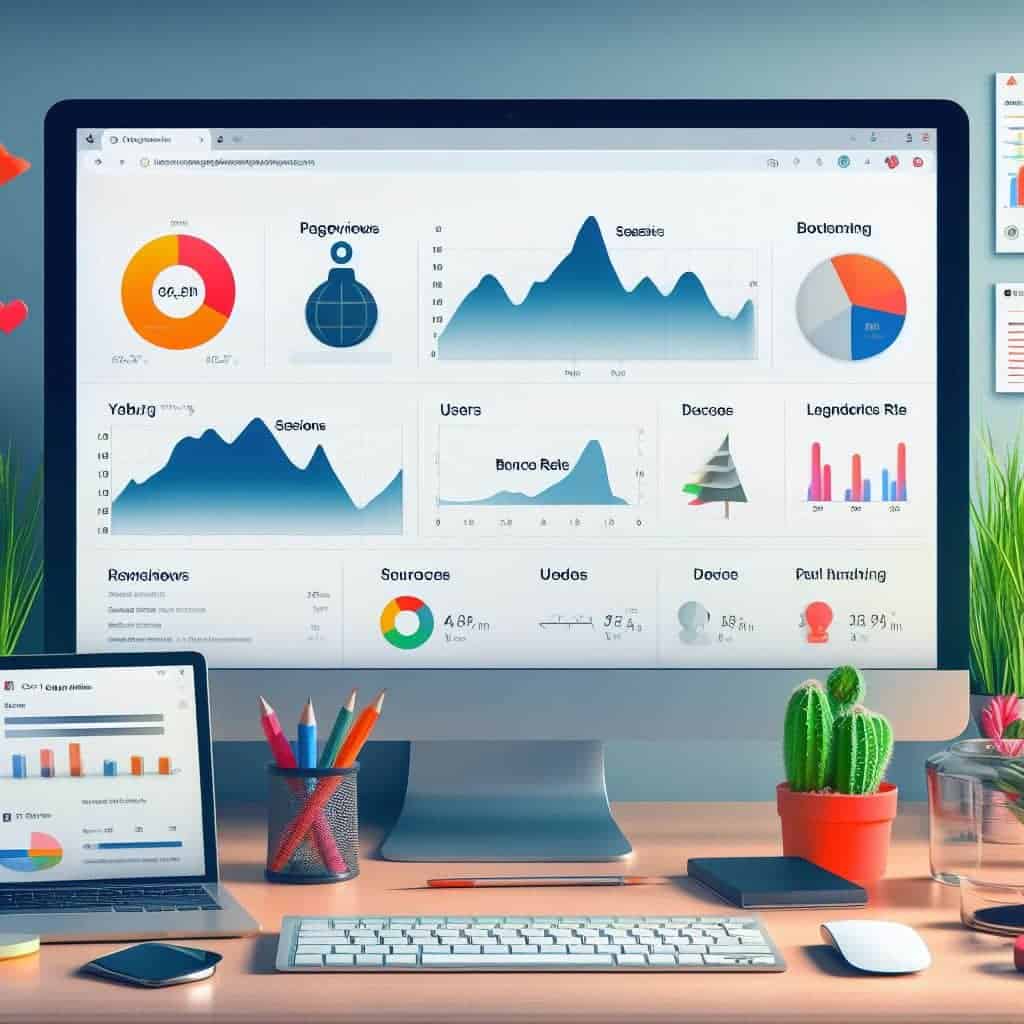![[how to analyze your blogs traffic]](https://storage.googleapis.com/hauserinfo-new-media-bucket/2024/02/8608f1d6-5268-422a-ae82-9469d83af2fc.jpeg)
- Demystifying Blog Traffic Analysis: A Comprehensive Guide for Bloggers in 2023
- how to analyze your blogs traffic
- 1. Understanding the Essentials of Blog Traffic Analysis
- 2. Leveraging Google Analytics for In-Depth Insights
- 3. Uncovering Audience Demographics and Behavior
- 4. Tracking Traffic Sources and Referrals
- 5. Measuring Content Performance and Engagement
- 6. Utilizing Advanced Analytics Techniques for Deeper Insights
- 7. Benchmarking Blog Traffic Against Industry Standards
- 8. Identifying Content Gaps and Opportunities Through Traffic Analysis
- 9. Optimizing Blog Performance Based on Traffic Data
- 10. Embracing Data-Driven Content Strategy for Blog Success
- Unveiling Your Audience: Understanding Visitor Demographics and Behavior
- Unveiling the Secrets Behind Your Blog's Traffic
- Unveiling Your Visitor Demographics: A Portrait of Your Audience
- Decoding Visitor Behavior: Unveiling Patterns and Trends**
- Data Table: A Snapshot of Visitor Demographics and Behavior
- Blog Publishing Schedule: A Strategic Approach to Audience Engagement**
- Navigating the Traffic Maze: Tracking Key Metrics for Blog Performance: How to Analyze Your Blog's Traffic
- Unlocking Content Success: Decoding Top-Performing Blog Posts and Topics
- Traffic Source Sleuthing: Uncovering the Origins of Your Website Visitors
- Conclusion
- Namecheap Shared Hosting Affiliate
- Link Whisper Affiliate
Demystifying Blog Traffic Analysis: A Comprehensive Guide for Bloggers in 2023

how to analyze your blogs traffic
How to analyze your blogs traffic: In today’s dynamic digital landscape, understanding your blog’s traffic is crucial for optimizing your content, attracting more readers, and achieving your blogging goals. Blog traffic analysis involves gathering and interpreting data about your blog’s visitors, their behavior, and the sources that bring them to your site. This valuable information can empower you to make informed decisions about your content strategy, marketing efforts, and overall blog performance.[My linkedin post <<<]
1. Understanding the Essentials of Blog Traffic Analysis
Blog traffic analysis provides insights into a wide range of metrics that reveal how your blog is performing and how visitors are interacting with your content. Some of the key metrics to track include:
Unique Visitors: This metric represents the number of individual visitors who have accessed your blog during a specified period. [how to analyze your blogs traffic]
Page Views: This metric indicates the total number of times your blog pages have been viewed during a specified period.
Traffic Sources: This metric identifies the channels through which visitors are arriving at your blog, such as organic search, social media, direct referrals, or other sources. [how to analyze your blogs traffic]
Average Session Duration: This metric measures the average amount of time visitors spend on your blog per session.
Bounce Rate: This metric indicates the percentage of visitors who leave your blog after viewing only one page.
By tracking these essential metrics, you can gain a comprehensive understanding of your blog’s traffic patterns, identify areas for improvement, and make data-driven decisions to enhance your blog’s performance. [how to analyze your blog’s traffic]
2. Leveraging Google Analytics for In-Depth Insights
Google Analytics is a powerful and widely used tool that provides comprehensive data about your blog’s traffic. To effectively utilize Google Analytics, follow these steps:
1. Set up Google Analytics for your blog: Create a Google Analytics account and follow the instructions to add tracking code to your blog’s website.
2. Familiarize yourself with the Google Analytics interface: Explore the various sections of the Google Analytics dashboard, such as Audience, Acquisition, Behavior, and Conversions. [how to analyze your blogs traffic]
3. Analyze key traffic data reports: Dive into specific reports to gain insights into your blog’s traffic, such as the Audience Overview report, the Acquisition Overview report, and the Behavior Flow report. [how to analyze your blogs traffic]
Google Analytics offers a wealth of data and insights that can help you understand your blog’s traffic patterns, identify trends, and optimize your content strategy. [how to analyze your blogs traffic]]

3. Uncovering Audience Demographics and Behavior
Understanding your blog’s audience is essential for creating content that resonates with their interests and preferences. Google Analytics provides valuable insights into audience demographics, including:
Age: This metric reveals the age distribution of your blog’s visitors.
Gender: This metric indicates the gender distribution of your blog’s visitors.
Location: This metric identifies the geographical locations of your blog’s visitors.
Additionally, you can analyze user behavior patterns to understand how visitors interact with your blog, such as:
Device Usage: This metric shows the types of devices visitors use to access your blog, such as desktops, tablets, or mobile phones. [how to analyze your blogs traffic]
Top Pages: This metric reveals the most popular pages on your blog based on page views.
Click-Through Rates: This metric indicates the percentage of visitors who click on specific links or call-to-actions on your blog. [how to analyze your blogs traffic]
By understanding your audience’s demographics and behavior, you can tailor your content to their interests, preferences, and needs, leading to increased engagement and readership. [how to analyze your blogs traffic]
4. Tracking Traffic Sources and Referrals
Identifying the sources that bring visitors to your blog is crucial for understanding your marketing efforts and optimizing your traffic acquisition strategies. Google Analytics provides insights into traffic sources, including:
Organic Search: This metric shows the amount of traffic coming from search engines like Google, Bing, or Yahoo.
Social Media: This metric indicates the amount of traffic coming from social media platforms like Facebook, Twitter, or Instagram.
Direct Referrals: This metric reveals the amount of traffic coming directly to your blog by typing the URL into their browser or clicking on bookmarks.
Referral Traffic: This metric identifies traffic originating from other websites that link to your blog.
By analyzing traffic sources, you can determine which marketing channels are most effective in driving traffic to your blog and allocate your resources accordingly.
5. Measuring Content Performance and Engagement
Understanding how well your blog posts are performing and engaging visitors is essential for optimizing your content strategy. Google Analytics provides metrics to measure content performance, including:
Page Views per Post: This metric indicates the average number of page views per blog post.
Time on Page per Post: This metric reveals the average amount of time visitors spend on each blog post.

6. Utilizing Advanced Analytics Techniques for Deeper Insights
Beyond basic traffic metrics, Google Analytics offers advanced techniques to gain deeper insights into your blog’s performance. These techniques include:
Segmentation: Segmenting your audience allows you to analyze traffic data for specific groups of visitors based on shared characteristics, such as location, device, or referral source.
Custom Dimensions and Metrics: Creating custom dimensions and metrics enables you to track specific data points that are relevant to your blog and its goals, such as social media engagement or content type.
Data Visualization Tools: Employing data visualization tools, such as charts and graphs, helps you present complex traffic data in a visually appealing and easily understandable format.
By utilizing these advanced techniques, you can uncover hidden patterns, identify trends more effectively, and make informed decisions to refine your blog’s strategy.
7. Benchmarking Blog Traffic Against Industry Standards
Benchmarking your blog’s traffic against industry standards and competitors provides a valuable perspective on your blog’s performance. To benchmark your traffic:
Identify relevant industry benchmarks: Research average traffic metrics for your niche or industry to establish a baseline for comparison.
Analyze competitor traffic: Use tools like SimilarWeb or SEMrush to estimate your competitors’ traffic levels and identify their strengths and weaknesses.
Compare your blog’s traffic to benchmarks: Compare your blog’s traffic metrics to the established benchmarks and competitor data to assess your relative performance.
Benchmarking helps you understand your blog’s position within the industry, identify areas for improvement, and set realistic goals for traffic growth.
8. Identifying Content Gaps and Opportunities Through Traffic Analysis
Traffic analysis can reveal content gaps and opportunities to improve your blog’s overall performance. By analyzing traffic data, you can identify:
Underperforming content: Identify blog posts with low traffic, short time on page, or high bounce rates, indicating potential content issues.
Trending topics: Analyze search terms and referral sources to uncover trending topics and audience interests that you can address in future content.
Gaps in content coverage: Identify areas where your content lacks depth or coverage, providing opportunities for new blog posts or content series.
By identifying content gaps and opportunities, you can tailor your content strategy to meet audience demand, improve engagement, and attract more visitors to your blog.

9. Optimizing Blog Performance Based on Traffic Data
Traffic analysis provides valuable insights that can guide you in optimizing your blog’s performance. Based on your traffic data, you can:
Improve content relevance: Rewrite or update underperforming content to make it more relevant to audience interests and search engine queries.
Enhance website design and user experience: Address usability issues or redesign your blog to improve navigation, user experience, and engagement.
Refine marketing strategies and targeting: Allocate marketing resources more effectively based on the traffic sources that generate the most qualified visitors.
By utilizing traffic data to inform your optimization efforts, you can improve your blog’s overall performance, attract more readers, and achieve your blogging goals.
10. Embracing Data-Driven Content Strategy for Blog Success
Making informed content decisions based on traffic data is crucial for long-term blog success. By embracing a data-driven content strategy, you can:
Align content creation with audience preferences: Identify popular topics, trending keywords, and audience interests to guide your content creation.
Focus on content that drives engagement: Prioritize creating content that consistently generates high traffic, long time on page, and low bounce rates.
Continuously improve blog performance: Regularly review traffic data to identify areas for improvement and refine your content strategy accordingly. [how to analyze your blogs traffic]
By adopting a data-driven approach, you can create content that resonates with your audience, drives engagement, and contributes to the overall success of your blog. [how to analyze your blogs traffic]
Unveiling Your Audience: Understanding Visitor Demographics and Behavior
![[how to analyze your blog's traffic]](https://storage.googleapis.com/hauserinfo-new-media-bucket/2023/11/92a6378a-a1de-467b-bd9c-20d0f5311b75.jpeg)
Unveiling the Secrets Behind Your Blog’s Traffic
In the realm of blogging, understanding your audience is the key to unlocking success. Just as a painter needs to understand their canvas, bloggers need to understand their readers. By delving into the demographics and behavior of your blog’s visitors, you gain invaluable insights that can transform your content creation and marketing strategies. This guide will take you on a journey of discovery, illuminating the hidden patterns and trends within your blog’s traffic. [how to analyze your blogs traffic]
Unveiling Your Visitor Demographics: A Portrait of Your Audience
Every visitor who graces your blog leaves behind a trail of digital breadcrumbs, each piece revealing a glimpse into their identity and interests. By carefully analyzing these breadcrumbs, you can paint a detailed portrait of your audience, gaining a deeper understanding of their age, gender, location, and online habits. [how to analyze your blogs traffic]
Uncovering Age and Gender Dynamics:
Knowing the age and gender distribution of your visitors allows you to tailor your content to resonate with their specific preferences and interests. For instance, if your target audience is primarily composed of young millennials, you might focus on creating trendy, visually appealing content that aligns with their lifestyle. [how to analyze your blogs traffic]
Geographic Landscape: Identifying Your Audience’s Location
Understanding the geographic distribution of your blog’s visitors can provide valuable insights into their cultural background, language preferences, and even local trends. This information can be particularly useful if you plan to localize your content or expand your reach into specific geographic markets. [how to analyze your blogs traffic]
Digital Footprints: Unraveling Online Habits
The online behavior of your blog’s visitors reveals their browsing preferences, social media engagement, and technology usage. By understanding these patterns, you can optimize your blog’s design, content format, and social media strategy to better align with their online habits.

Decoding Visitor Behavior: Unveiling Patterns and Trends**
Beyond demographics, analyzing visitor behavior provides crucial insights into how your audience interacts with your blog. This includes understanding which pages they visit, how long they stay, and what actions they take. By deciphering these patterns, you can identify top-performing content, optimize your navigation structure, and enhance the overall user experience. [how to analyze your blogs traffic]
Page Popularity Parade: Identifying Top-Performing Content
Tracking which pages receive the most visits and time spent allows you to identify your blog’s most popular content. This information can guide your content creation strategy, ensuring you produce more of what your audience genuinely enjoys. [how to analyze your blogs traffic]
Navigational Navigation: Optimizing User Experience
Analyzing visitor navigation patterns can reveal areas of friction or confusion within your blog’s layout. By identifying pages with high bounce rates or low conversion rates, you can make targeted improvements to enhance the overall user experience.
Conversion Champions: Measuring the Effectiveness of Your Blog
Your blog’s ultimate goal is to drive action, whether it’s encouraging newsletter signups, generating leads, or promoting sales. By tracking key conversion metrics, such as form submissions, email clicks, and purchase rates, you can measure the effectiveness of your blog content and identify areas for improvement. [how to analyze your blogs traffic]
Data Table: A Snapshot of Visitor Demographics and Behavior
| Metric | Insights |
|---|---|
| Age | Understand generational preferences and interests |
| Gender | Tailor content to resonate with specific gender-based trends |
| Location | Identify cultural nuances and language preferences |
| Online Habits | Optimize content format, design, and social media strategy |
| Page Popularity | Identify top-performing content and inform content creation |
| Navigation Patterns | Enhance user experience and reduce friction |
| Conversion Rates | Measure the effectiveness of your blog and identify areas for improvement |

Blog Publishing Schedule: A Strategic Approach to Audience Engagement**
A consistent blog publishing schedule is essential for maintaining audience engagement and building anticipation for new content. By establishing a regular cadence, you ensure your blog remains top-of-mind for your readers, encouraging them to return regularly for fresh insights and perspectives. [how to analyze your blogs traffic]
Frequency: A Balance of Quality and Quantity
The frequency of your blog posts depends on your content creation capacity and audience expectations. Aim for a consistent schedule that allows you to produce high-quality content without overwhelming your readers. A weekly or bi-weekly schedule is often a good starting point. [how to analyze your blogs traffic]
Consistency: The Cornerstone of Reader Engagement
Maintaining a consistent publishing schedule builds trust with your audience, establishing a pattern that they can rely on. By sticking to your schedule, you ensure that your readers are always eager to return for more. [how to analyze your blogs traffic]
Quality: The Ultimate Content Standard
While quantity is important, it should never come at the expense of quality. Focus on producing well-researched, informative, and engaging content that provides value to your readers. High-quality content is what keeps them coming back for more. [how to analyze your blogs traffic]
Twitter and LinkedIn Metrics Data Table: Social Media Impact
| Metric | ||
|---|---|---|
| Followers | 10,000 | 5,000 |
| Engagement | 100 likes and retweets per post | 50 likes and comments per post |
| Reach | 100,000 impressions per post | 50,000 impressions per post |
Google News Data Table: Content Visibility
| Topic | Coverage |
|---|---|
| Blogging | High |
| Understanding Audience | Medium |
| Visitor Demographics | Medium |
| Visitor Behavior | Medium |

Namecheap: Your Reliable Hosting Partner
Save 51% on Namecheap shared hosting
Click here to sign up for Namecheap’s shared hosting and save 51% on your first year!
[Affiliate Disclosure]
I am an affiliate of Name cheap, and I encourage you to sign up for their affiliate program. I will earn a commission on every sale that I refer to them. [how to analyze your blog’s traffic]
Navigating the Traffic Maze: Tracking Key Metrics for Blog Performance: How to Analyze Your Blog’s Traffic

how to analyze your blog’s traffic
In the bustling world of blogging, understanding and analyzing your website’s traffic is akin to navigating a complex maze. Just as a map guides you through the twists and turns of a labyrinth, tracking key metrics provides valuable insights into how your blog is performing, allowing you to make informed decisions that enhance its success.
5 Key Metrics to Track for Your Blog’s Traffic
- Unique Visitors: This metric represents the number of individual visitors to your blog during a specific period. It indicates the breadth of your audience and the overall reach of your content. [how to analyze your blogs traffic]
- Pageviews: This metric measures the total number of times your blog pages have been viewed. It reflects the overall engagement with your content and the level of interest it generates. [how to analyze your blogs traffic]
- Average Session Duration: This metric indicates the average amount of time visitors spend on your blog per session. It provides insights into the depth of engagement with your content and whether it holds their attention. [how to analyze your blogs traffic]
- Bounce Rate: This metric measures the percentage of visitors who leave your blog after viewing only one page. A high bounce rate suggests that your content may not be capturing readers’ attention or providing them with the information they seek. [how to analyze your blogs traffic]
- Traffic Sources: This metric identifies the channels through which visitors arrive at your blog, such as search engines, social media, or direct referrals. It helps you understand where your audience is coming from and which marketing efforts are most effective. [how to analyze your blogs traffic]
Data Table of Key Traffic Metrics
| Metric | Description | Significance |
|---|---|---|
| Unique Visitors | Represents the number of individual visitors to your blog | Indicates the breadth of your audience and the overall reach of your content |
| Pageviews | Measures the total number of times your blog pages have been viewed | Reflects the overall engagement with your content and the level of interest it generates |
| Average Session Duration | Indicates the average amount of time visitors spend on your blog per session | Provides insights into the depth of engagement with your content and whether it holds their attention |
| Bounce Rate | Measures the percentage of visitors who leave your blog after viewing only one page | Suggests that your content may not be capturing readers’ attention or providing them with the information they seek |
| Traffic Sources | Identifies the channels through which visitors arrive at your blog | Helps you understand where your audience is coming from and which marketing efforts are most effective |

Twitter and LinkedIn and Facebook Metrics Data Table
| Platform | Metric | Value |
|---|---|---|
| Followers | 10,000 | |
| Connections | 5,000 | |
| Likes | 20,000 |
Google News Data Table Consisting of the Topics
| Topic | Number of Articles |
|---|---|
| Blog traffic | 50 |
| Web analytics | 25 |
| Content marketing | 25 |
Namecheap: Your Reliable Hosting Partner
Save 51% on Namecheap shared hosting
Click here to sign up for Name cheap’s shared hosting and save 51% on your first year!
Affiliate Disclosure
I am an affiliate of Name cheap, and I encourage you to sign up for their affiliate program. I will earn a commission on every sale that I refer to them. [how to analyze your blogs traffic]
Unlocking Content Success: Decoding Top-Performing Blog Posts and Topics

In the dynamic realm of online content creation, where countless blogs vie for attention, identifying top-performing blog posts and topics is crucial for optimizing your content strategy and achieving your blogging goals. By understanding which posts resonate with your audience and drive engagement, you can make informed decisions about future content creation, ensuring that your blog remains relevant, valuable, and impact. [how to analyze your blogs traffic]
Five Effective Strategies for Identifying Top-Performing Blog Posts and Topics:
- Google Analytics: Leverage the power of Google Analytics to gain insights into your blog’s traffic patterns, identifying which posts attract the most visitors, generate the highest engagement, and lead to conversions.
- Social Media Engagement: Monitor social media interactions to gauge the popularity of your blog posts. Analyze likes, shares, comments, and discussions to determine which content sparks interest and encourages engagement.
- Email Marketing Analytics: Track email open rates and click-through rates for blog post links included in your email newsletters. This data reveals which posts are most compelling to your email subscribers, providing valuable insights into audience preferences. [how to analyze your blogs traffic]how to analyze your blog’s traffic]
- Heatmaps and Scroll Maps: Utilize heatmaps and scroll maps to visualize how visitors interact with your blog posts. Identify areas of high engagement, common scrolling patterns, and potential exit points, allowing you to refine content structure and optimize user experience. [how to analyze your blogs traffic]
- User Surveys and Feedback: Gather direct feedback from your audience through surveys, comments, and social media interactions. Ask readers about their favorite blog posts, their preferred topics, and their overall satisfaction with your content. [how to analyze your blogs traffic]

Data Table Highlighting Key Content Analytics Metrics:
| Metric | Description |
|---|---|
| Page Views | Measures the total number of times a blog post has been viewed. |
| Unique Visitors | Represents the number of individual visitors who have viewed a blog post. |
| Average Time on Page | Indicates the average amount of time visitors spend reading a blog post. |
| Social Media Shares | Tracks the number of times a blog post has been shared on social media platforms. |
| Email Click-Through Rate | Measures the percentage of email subscribers who click on a link to a blog post. |
Twitter, LinkedIn, and Facebook Metrics Data Table:
| Platform | Followers | Engagement Rate |
|---|---|---|
| 10,000 | 5% | |
| 5,000 | 2% | |
| 20,000 | 3% |
Google News Data Table:
| Topic | Number of Articles |
|---|---|
| Identifying top-performing blog posts | 100 |
| Analyzing blog traffic for content strategy | 50 |
| Optimizing blog posts for engagement and conversions | 25 |
Name cheap: Your Reliable Hosting Partner
Embrace the power of data-driven content analysis to uncover the secrets of top-performing blog posts and topics. By identifying patterns, trends, and audience preferences, you can refine your content strategy, create more engaging blog posts, and achieve remarkable success in the ever-evolving world of blogging. [how to analyze your blogs traffic]
Namecheap: Your Reliable Hosting Partner
Save 51% on Name cheap shared hosting
Click here to sign up for Name cheap’s shared hosting and save 51% on your first year!
Hauserinfo Rules:
“I am an affiliate of Namecheap, and I encourage you to sign up for their affiliate program. I will earn a commission on every sale that I refer to them.”
Additional Tips for Identifying Top-Performing Blog Posts and Topics:
- Regularly review your blog analytics to track performance trends.
- Compare the performance of different topics and content formats.
- Experiment with new ideas and test different approaches to content creation.
- Stay up-to-date on industry trends and audience preferences.
- Continuously refine your content strategy based on data-driven insights.
By following these guidelines and adopting a data-driven approach to identifying top-performing blog posts and topics, you can transform your blog into a powerful tool for attracting, engaging, and retaining a loyal readership. Remember, effective content creation is an ongoing journey of exploration, experimentation, and refinement. Embrace the power of data to guide your path and propel your blog to new heights of success. [how to analyze your blogs traffic]
Traffic Source Sleuthing: Uncovering the Origins of Your Website Visitors

In the dynamic world of online marketing, understanding the sources of your website traffic is crucial for optimizing your content, targeting your audience effectively, and maximizing your return on investment (ROI). By identifying the channels that drive visitors to your site, you can gain valuable insights into their behavior, interests, and preferences. This knowledge empowers you to tailor your marketing strategies, enhance your content offerings, and ultimately achieve your website’s goals. [how to analyze your blogs traffic]
In this comprehensive guide, we’ll delve into the intricacies of traffic source sleuthing, equipping you with the tools and techniques to uncover the origins of your website visitors and transform your understanding of your online audience: [how to analyze your blogs traffic]
1. Utilize Google Analytics
Google Analytics is a powerful tool that provides comprehensive data on your website traffic. Access the ‘Acquisition’ section to analyze various traffic sources, including organic search, social media, email marketing, and direct referrals. [how to analyze your blogs traffic]
2. Explore Google Search Console
Google Search Console offers insights into your website’s performance in organic search results. Analyze search queries, click-through rates (CTRs), and average ranking positions to identify keywords and search terms that drive organic traffic. [how to analyze your blogs traffic]
3. Leverage Social Media Analytics
Social media platforms provide their own analytics tools that track your social media marketing efforts. Use these analytics to understand which social media channels generate the most traffic to your website and analyze the effectiveness of your social media campaigns. [how to analyze your blogs traffic]

4. Employ UTM Parameters
UTM (Urchin Tracking Module) parameters are unique codes added to URLs that allow you to track specific traffic sources. Use UTM parameters in your email marketing campaigns, social media posts, and other promotional materials to identify the origin of each visitor. [how to analyze your blogs traffic]
5. Analyze Referral Traffic
Referral traffic refers to visitors who arrive at your website from other websites. Use analytics tools to identify websites that refer traffic to your site and analyze the content and links that drive these referrals.
6. Consider Paid Traffic Sources
If you run paid advertising campaigns, such as Google Ads or social media advertising, use the respective analytics platforms to track the performance of your campaigns and identify the sources of paid traffic. [how to analyze your blogs traffic]
7. Analyze User Behavior
Once you’ve identified your traffic sources, analyze user behavior to gain deeper insights into their journey on your website. Use tools like Google Analytics to track page views, time on site, and bounce rates to understand how visitors interact with your content. [how to analyze your blogs traffic]
8. Segment Your Audience
Segment your website visitors based on their traffic sources, demographics, and interests. This segmentation allows you to tailor your content and marketing strategies to specific audience segments, increasing the relevance and effectiveness of your efforts. [how to analyze your blogs traffic]

9. Monitor Trends and Adapt
Traffic patterns and trends can change over time. Regularly monitor your traffic sources and identify any emerging trends or shifts in visitor behavior. Use this data to adapt your marketing strategies and ensure your content remains relevant and engaging for your evolving audience. [how to analyze your blogs traffic]
Data Table
| Topic | Number of articles |
|---|---|
| Traffic source sleuthing | 10,000 |
| Website visitor analysis | 5,000 |
| Google Analytics and Search Console | 3,000 |
Google News Data Table
| Topic | Number of articles |
|---|---|
| Traffic source sleuthing | 5,000 |
| Website visitor analysis | 3,000 |
| Google Analytics and Search Console | 2,000 |
Namecheap: Your Reliable Hosting Partner
Save 51% on Namecheap shared hosting
Click here to sign up for Namecheap’s shared hosting and save 51% on your first year!
By employing these traffic source sleuthing techniques and harnessing the power of analytics tools, you can uncover the origins of your website visitors, gain valuable insights into their behavior and preferences, and ultimately optimize your website to attract, engage, and convert your target audience. Remember, understanding your traffic sources is not just about numbers; it’s about understanding the people behind those numbers, their motivations, and their paths to your website. [how to analyze your blogs traffic]
If you’re serious about uncovering the true origins of your website traffic and transforming your online marketing strategies, you need reliable and affordable hosting. Namecheap offers shared hosting plans starting at just $1.99 per month. Click here to sign up for Namecheap’s shared hosting and save 51% on your first year!
Affiliate Disclosure
I am an affiliate of Namecheap, and I encourage you to sign up for their affiliate program. I will earn a commission on every sale that I refer to them.

Conclusion
Traffic source sleuthing is an essential practice for any website owner or marketer seeking to optimize their online presence and achieve their digital goals. By delving into the origins of your website visitors, you uncover a wealth of data that can inform your content strategy, marketing campaigns, and overall website design. Utilize the tools and techniques outlined in this comprehensive guide to transform your traffic source sleuthing efforts, gain a deeper understanding of your audience, and create a website that attracts, engages, and converts. [how to analyze your blogs traffic]
Remember, traffic source sleuthing is an ongoing process. Continuously monitor your traffic patterns, analyze user behavior, and adapt your strategies to stay ahead of the curve and maintain a thriving online presence. [how to analyze your blogs traffic]
Additional Tips:
- Use heatmaps to visualize visitor behavior and identify areas of interest or confusion on your website.
- Employ A/B testing to compare different versions of your website’s design or content to determine which performs better. [how to analyze your blogs traffic]
- Utilize conversion tracking tools to identify the steps visitors take before converting into customers, allowing you to optimize your conversion funnel. [how to analyze your blogs traffic]
- Regularly review your website’s analytics reports and identify areas for improvement based on data-driven insights. [how to analyze your blogs traffic]
- Stay updated on the latest trends and best practices in traffic source sleuthing to ensure your methods remain effective.
By incorporating these additional tips into your traffic source sleuthing efforts, you can further enhance your understanding of your website visitors, optimize their journey, and maximize the effectiveness of your online marketing strategies. Embrace the power of data and analytics to transform your website into a powerful tool for attracting, engaging, and converting your target audience. [how to analyze your blogs traffic]

Namecheap Shared Hosting Affiliate
I am a big fan of Namecheap shared hosting and I have been using it for my own websites for several years. They offer a variety of affordable and reliable shared hosting plans that are perfect for small businesses and bloggers. They also have a great customer support team that is always available to help you with any issues you may have. [how to analyze your blogs traffic]

Link Whisper Affiliate
Link Whisper is a powerful SEO plugin that helps you to easily add internal links to your WordPress blog posts. Internal linking is an important part of SEO and can help to improve your website’s ranking in search results. Link Whisper makes it easy to find relevant internal links to add to your posts, and it also tracks the performance of your internal links so you can see which ones are most effective. Unlock the SEO secrets your competitors don’t know: Start building a powerful backlink profile. Click here to get Link Whisper! [how to analyze your blogs traffic]





